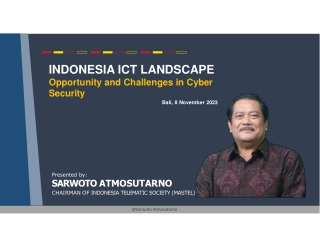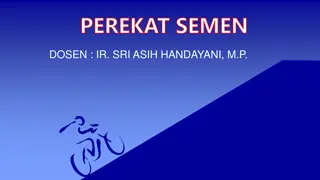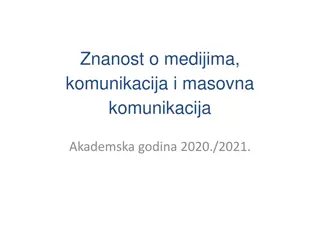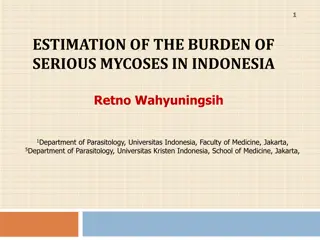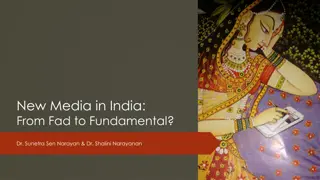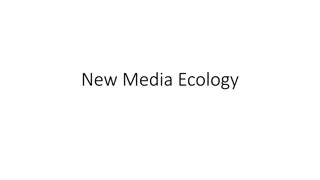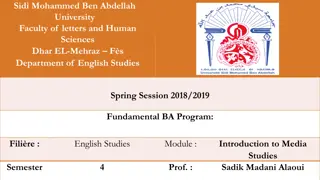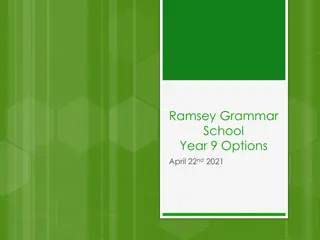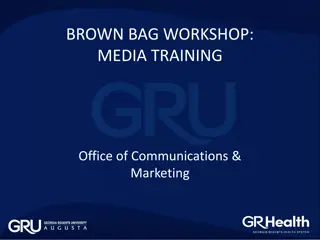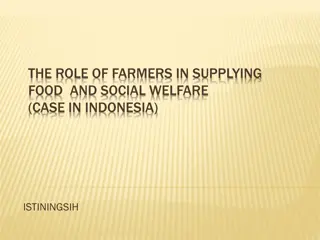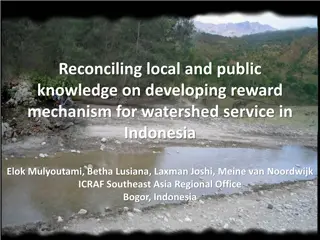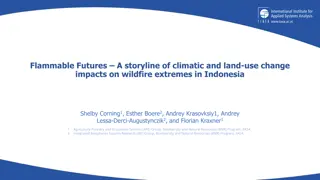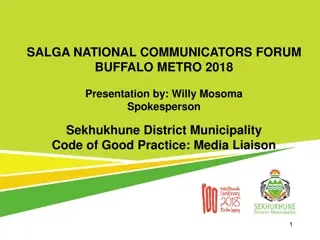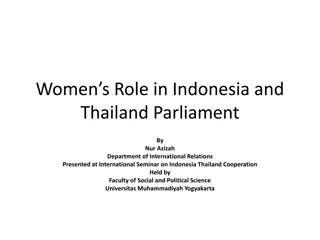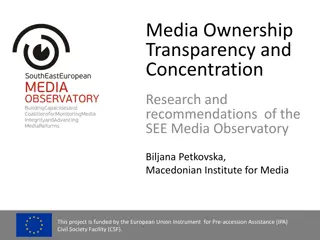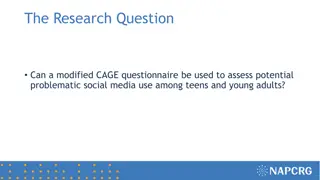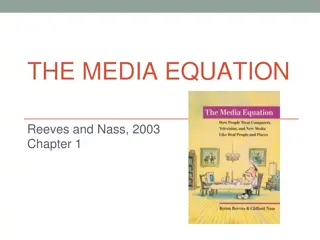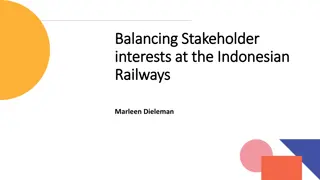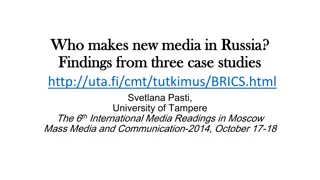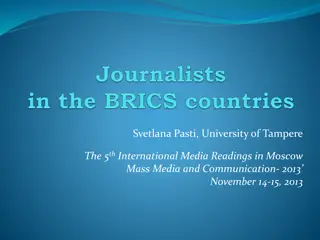Media Use in Indonesia: Insights from 2012 Study
This study presents findings on media consumption patterns in Indonesia based on a 2012 research project. It includes data on media usage, daily consumption habits, and preferred sources of information. The report reflects insights gathered from a nationally representative sample of adults over a month-long field period.
Download Presentation

Please find below an Image/Link to download the presentation.
The content on the website is provided AS IS for your information and personal use only. It may not be sold, licensed, or shared on other websites without obtaining consent from the author.If you encounter any issues during the download, it is possible that the publisher has removed the file from their server.
You are allowed to download the files provided on this website for personal or commercial use, subject to the condition that they are used lawfully. All files are the property of their respective owners.
The content on the website is provided AS IS for your information and personal use only. It may not be sold, licensed, or shared on other websites without obtaining consent from the author.
E N D
Presentation Transcript
Media Use in Indonesia Findings from the 2012 International Audience Research Project
Survey Background and Conditions Target population: Adults 15 and older living in households Population Coverage: 93% of adult population in Indonesia 11 provinces were excluded (North Sulawesi, Central kalimantan, South East Sulawesi, Riau Island, Benkulu, Maluku, Bangka Belitung, Gorontalo, West Sulawesi, North Maluku, West Papua) Sample size: 3,000 nationally representative, oversample in Jakarta Language: Indonesian Methodology: Interviews were collected face-to-face in respondent s home Field Period: July 4th Aug 2nd, 2012 Response rate: 74% 4
Television and Mobile Phones are most popular in Indonesian households Which of the following do you have working in your household? Total (n=3000) Urban (N=940) Rural (N=2060) 98% 94% 90% 91% 81% 72% 44% 38% 33% 22% 23% 20% 16% 17% 17% 13% 11% 10% 10% 5% 1% Television Mobile phone Radio Internet access MP3 Computer Telephone land line player/iPod Base: All respondents, N=3000 6
Daily Use of Media Platforms for News Total (N=3000) Urban (N=940) Rural (n=2060) 92% 87% 83% 48% 47% 39% 36% 29% 25% 14% 12% 12% 11% 10% 10% 9% 9% 7% 6% 5% 4% 3% 3% 2% Television Friends/ Family SMS Radio Newspapers/ Magazines Internet Social Networking Mobile Apps 7
Daily Media Use for News, by Demographic Total (N=3000) Under 30 (N=797) Some College or higher (N=100) 91% 89% 87% 71% 59% 55% 45% 41% 39% 36% 36% 34% 21% 21% 14% 12% 12% 11% 9% 9% 8% 7% 7% 3% TV Friends/ Family SMS Radio Internet Social Networking Press Mobile Apps 8
Most Important Information Source (net) Which stations, publications, or sites are your three MOST important sources of information? Total (N=3000) Urban (N=940) Rural (N=2060) 59% 57% 56% 41% 39% 39% 37% 36% 34% 33% 32% 32% 31% 31% 28% 27% 25% 18% 16% 15% 14% 15% 13% 11% 11% 10% 8% 6% 5% 4% RCTI SCTV TV One Metro TV Trans TV Indosiar ANTV MNC TV TVRI Global TV 9
Satellite Dish More Prevalent in Rural Areas How does your television receive its signal? Antenna Satellite Dish Cable 91% 75% 69% 28% 23% 9% 3% 3% 2% Total Urban Rural N=2784 N=913 N=1871 10
Significant Regional Difference in TV Signal Access Antenna Satellite dish Cable 93% 90% 88% 65% 63% 56% 55% 47% 37% 35% 22% 18% 10% 9% 8% 6% 2% 2% 1% 0% 0% Sumatera West Java/ Jakarta/ Banten East Java Central Java/ Yogjakarta Sulawesi Kalimanten Bali/ NTB/ NTT N=114 N=579 N=151 N=512 N=141 N=524 N=763 11
Radio ownership and its use for news continues its decline Radio Ownership Past Week Radio Use for News 50% 46% 38% 34% 31% 24% 2010 2011 2012 N=3000 N=3000 N=3000 13
Significant Growth in New Media Access Which of the following do you have working in your household? Computer Internet access Mobile phones 81.0% 69.0% 67.0% 56.0% 16.2% 10.0% 16.6% 8.0% 6.9% 5.0% 4.0% 1.8% 2009 2010 2011 2012 N=3000 N=3000 N=3000 N=3000 14
New Media Usage Trends Past week use of Facebook Past week Internet Use Personal ownership of mobile 63% 58% 54% 22% 15% 12% 21% 15% 11% 2010 2011 2012 N=3000 N=3000 N=3000 15
Mobile Ownership Trends, by Urbanicity Urban Rural 71% 67% 64% 55% 51% 45% 2010 2011 2012 N=3000 N=3000 N=3000 16
Past Week Internet Usage Trends, by Urbanicity Urban Rural 30% 21% 18% 17% 10% 8% 2010 2011 2012 N=3000 N=3000 N=3000 17
Mobile 18
Personal Mobile Phone Access Most Prevalent Among Young And Most Educated Percentage who report having a personal mobile phone 99% 89% 87% 78% 72% 71% 63% 55% 55% 41% 25% 19
Reported Smartphone Ownership, by Age 26% 16% 13% 7% 2% 15-24 25-34 35-54 55+ All ages 15+ N=468 N=738 N=509 N=3000 N=1285 20
SMS and Text Messaging Most Common Use of Mobile Watched live television 5% Rcvd. news reports by SMS from other news organizations 7% Sent or received an email 8% Downloaded or used a mobile app 10% Downloaded and viewed a video clip 14% Rcvd. Info. by SMS from mobile operator 20% Listened to radio 22% Sent a photo 24% Accessed the internet 27% Social networking site 30% SMS/Text messages 97% Base: Those who have a personal mobile phone N=2,083 21
Past Week Mobile Activities, by Age 30+ (N=2203) Under 30 (N=797) 3% Watched live TV 7% 7% Received SMS news from other news.. 8% 4% Sent/received email 12% 5% Downloaded mobile app 17% 5% Viewed video clip 24% SMS info from mobile operator 20% 21% 15% Listened to radio 31% 12% Sent photo 38% 11% Access Internet 46% 12% Social networking 50% 95% SMS/Text 100% 22
Information Would Like to Receive Through SMS Without Any Cost To Individuals 77% 77% 53% 52% 51% 48% News headlines about events in the country Health Advice Information on News headlines about world events Weather reports Sports Scores Crop or food prices Base: Those who have a personal mobile phone N=2,083 23
Internet 24
Past Week Internet Use, by Age 51% 25% 21% 11% 2% 15-24 25-34 35-54 55+ All ages 15+ N=468 N=738 N=1285 N=3000 N=509 25
Past Week Internet Use, by Urbanicity 30% 23% 13% Rural (N=1661) Small town (N=774) Large city (N=565) 26
Past Week Internet Use, by Education 72% 46% 40% 21% 3% 1% None (N=97) Primary (N=1157) Secondary (N=742) High School (N=695) Vocational (N=209) University (N=100) 27
Internet Use by Intensity of News Consumption Percent of each group using internet daily for news 20% 14% 8% 4% 3% 1% Hourly or more (N=262) 2/3 times a day (N=745) Once a day (N=1072) 2/3 times a week (N=356) Once a week (N=144) Less often (N=349) Frequency with which respondents access news 28
Vast Majority of Regular Users of Internet Access the Latest News In the last 7 days, which of the following activities have you used the Internet for 72% 50% 44% 38% 35% 32% 29% 28% 27% 21% Past 7 day use of Internet Latest news To find information about specific topic To send or receive email Read a blog Share videos or photos online Watch online videos Listen to online audio Post a comment to a blog Download or watch podcast Base: Regular user of Internet N=433 29
Where Internet is Used, by Age All Past Week Users (N=433) Under 30 [N=296] 30+[N=137] 78% 72% 70% 68% 66% 61% 57% 54% 49% 32% 27% 26% 22% 19% 7% At home At work Internet caf At school/ university Mobile device 30
Where Web Users go for News First Second Third 6% 22% 7% 23% 7% 32% 11% 1% 14% 2% 4% 10% 4% 2% 3% 6% 4% 3% 2% 2% Yahoo News Google Detik Facebook Okezone KapanLagi Kompas VivaMedia Base: Past Week Internet Users, N=433 31
Facebook the most accessed Social Networking Service Which of the following services have you used in the past 7 days for social networking? Toko Bagus 1% MySpace 1% Yahoo 1% Friendster 1% Kaskus 1% Twitter 7% Google Plus 8% YouTube 11% Facebook 22% Past week Access 22% Base: All respondents, N=3000 33
Used Social Networking in Last Week, by Age 56% 27% 22% 7% 1% 15-24 25-34 35-54 55+ All ages 15+ N=3000 N=738 N=468 N=1285 N=509 34
Frequency of Information Sharing How often do you discuss or share news with family, friends, or your social network 30% 30% 16% 12% 10% Daily/almost Weekly Monthly Less often Never Base: All Respondents, N=3000 35
Frequency of Information Sharing: Internet Users vs Others Internet Users[N=413] Others[N=2587] 41% 40% 28% 28% 17% 15% 11% 9% 7% 3% Daily/almost Weekly Monthly Less often Never 36
Means of Information Sharing Do you share news with your friends, family, or social networks in any of the following ways? 64% 28% 9% 9% 8% 7% SMS Facebook or other S/N By email Twitter Online video like YouTube BBM Base: Daily/Almost News Sharers, N=821 37
Means of Information Sharing, by Age Under 30 (N=234) 30 + (N=587) 82% 57% 53% 20% 17% 16% 11% 10% 5% 4% 4% 3% BBM Online video like YouTube By email Twitter Facebook or other S/N SMS 38
Key Information Sources: Prospects for Change? TV Radio Press Internet 93% 90% 90% 87% 12% 8% 6% 2% 1% 1% 1% 1% 1% 1% 1% 0% All Under 30 College or higher Urban N=3000 N=797 N=100 N=940 39
Conclusions Television remains the most important medium by far, both in terms of overall reach and as a news source Internet access heavily driven by mobile take-up has reached critical mass, especially among key demographics This phenomenon is national in nature and not just confined to more affluent urban areas Given the heavy reliance on mobile for Internet access; Internet content needs to work well on mobile platforms Any communications strategy for Indonesia has to take into account the large and growing role of social media, especially among the young It s only the beginning 40
Upcoming BBG Research Series Events Upcoming BBG Research Series events: Thursday, November 8: Russia Thursday, December 6: To be announced. Learn more about the BBG Research series at http://j.mp/UjCmJb Have a question? Contact us at 202-203-4400 or pubaff@bbg.gov



